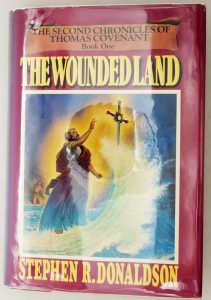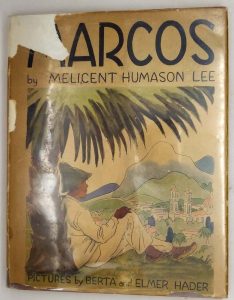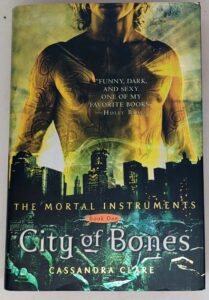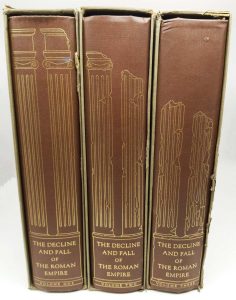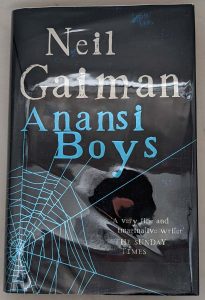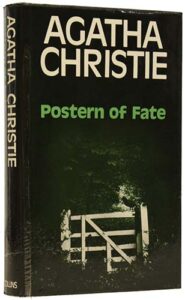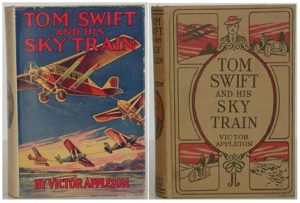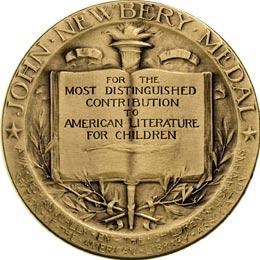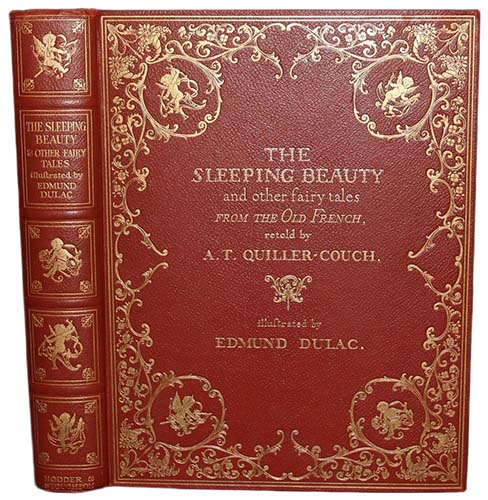
The Sleeping Beauty and Other Fairy Tales (1910), selected by Sir Arthur Quiller-Couch and illustrated by Edmund Dulac, represents the zenith of Edwardian gift-book opulence. Published by Hodder & Stoughton in London, this lavish volume weaves together European fairy tales through Dulac’s sumptuous paintings that blend Persian miniature precision with Art Nouveau fluidity. His illustrations for the title story transform Perrault’s classic into a dreamlike tableau—the sleeping princess sprawled across her canopied bed, her flowing golden hair cascading over embroidered silks while the enchanted court slumbers in gilded decay, their forms half-consumed by creeping vines. Dulac’s color palette of molten golds, royal purples, and ivoried flesh tones creates a hypnotic atmosphere, particularly in the climactic awakening scene where the prince’s kiss releases a visual symphony of unfurling rose petals and shimmering light. The companion tales (“Blue Beard,” “Cinderella,” and Andersen’s “The Emperor’s New Clothes”) each receive Dulac’s signature treatment: Blue Beard’s wives materialize as spectral figures in a stained-glass window, Cinderella’s pumpkin coach glows with ethereal luminosity against a midnight-blue sky, and the vain emperor’s “invisible” robes ripple with sheer, mocking transparency. The Limited Edition on thick vellum paper, gilt-tooled crimson binding, and Dulac’s illustrations reproduced through meticulous color separation—makes this one of the most technically ambitious artistic achievements of early 20th-century publishing.
About Edmund Dulac (1882-1953):
The French-born artist reached new heights of creative mastery with this 1910 masterpiece, his third major commission for Hodder & Stoughton. Trained in Toulouse and Paris, Dulac had already dazzled audiences with Stories from Arabian Nights (1907) before perfecting his style in this volume—where his opaque watercolor technique achieved unprecedented jewel-like intensity. Unlike contemporaries who used transparent washes, Dulac layered pigments like tempera, allowing him to build the rich, enameled surfaces seen in the Sleeping Beauty’s brocaded gown or Blue Beard’s lacquered armor. His approach to fairy tales rejected Victorian prettiness in favor of psychological depth and authentic cultural details—the Chinese-inspired “Nightingale” illustrations showcase his meticulous research into Asian art, just as his “Sleeping Beauty” settings reference Versailles’ Hall of Mirrors. Financial pressures later forced Dulac into magazine and stamp work, but these 1910 illustrations remain his most influential, directly inspiring Walt Disney’s early animation aesthetics. Original paintings from this edition, particularly the haunting “Blue Beard’s Chamber,” now anchor museum collections from the British Museum to the Metropolitan.
For collectors of this edition, these complementary works may captivate:
• Hans Andersen’s Fairy Tales (1911) illustrated by Dulac – his other notable fairy tale interpretation
• The Sleeping Beauty (1920) illustrated by Arthur Rackham – offering a contrasting Art Nouveau vision
• Perrault’s Fairy Tales (1922) illustrated by W. Heath Robinson – presenting earlier Edwardian style
Other books illustrated by Edmund Dulac available in our gallery: Stories from the Arabian Nights, Lyrics, Pathetic and Humourous from A to Z, The Rubaiyat of Omar Khayyam, The Sleeping Beauty, Stories from Hans Andersen, The Bells, and other poems, Princess Badoura, Sindbad the Sailor and other stories, The Kingdom of the Pearl.
Complete list of books illustrated by Edmund Dulac.
